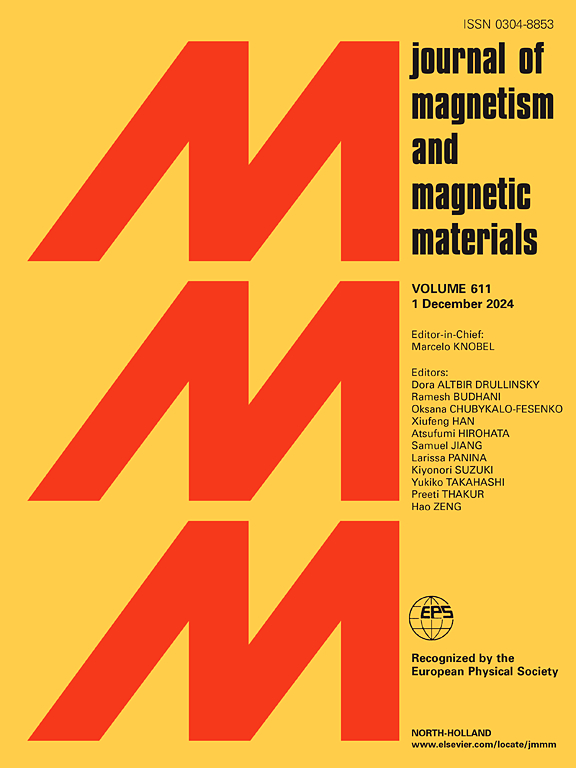Studies on structural, magnetic and corrosion properties of Novel Co35Cr5Fe10Ni30Ti5Al10-x Mn5+x (x = 0, 2.5, 5) high entropy alloys
IF 2.5
3区 材料科学
Q3 MATERIALS SCIENCE, MULTIDISCIPLINARY
引用次数: 0
Abstract
We investigated the effect of the presence of both Mn and Al on magnetic and corrosion properties of Co35Cr5Fe10Ni30Ti5Al10-xMn5+x (x = 0, 2.5, 5) High Entropy Alloys (HEAs). Three different HEAs were synthesized through the mechanical alloying technique and investigated for the phase formation, and its correlation with the magnetic properties. At the as synthesized stage a single fcc phase is formed due to the addition of 7th alloying element in Co35Cr5Fe10Ni30Ti5Al10-x Mn5+x (x = 0, 2.5, 5) HEAs. However, after annealing at 700 ̊C for 2 h, a small amount of bcc and σ-phase are precipitated along with the fcc phase for the Co35Cr5Fe10Ni30Ti5Al10-xMn5+x (x = 0, 2.5, 5) HEAs. The value of Ms and Hc are found 73 emu/g & 18 Oe, 71 emu/g & 15 Oe and 71 emu/g & 17 Oe for the as- synthesized Co35Cr5Fe10Ni30Ti5Al10-x Mn5+x HEAs (x = 0, 2.5, 5) respectively. However, after annealing of the as synthesized HEA at 700℃ 2 h, the value of Ms (102–106 emu/g), Hc (47–49 Oe) and Mr (2.26–2.48 emu/g) are increased significantly. The increment in the value of Ms for the annealed HEAs is associated with the decrease in the lattice parameter and dislocation density of the fcc phase as compared to the as- synthesized HEAs. We also investigated the corrosion resistance of annealed Co35Cr5Fe10Ni30Ti5Al10-x Mn5+x (x = 0, 2.5, 5) HEAs and found good corrosion resistance for the developed HEA as compared to the recently reported HEAs and conventional soft magnetic materials.

求助全文
约1分钟内获得全文
求助全文
来源期刊

Journal of Magnetism and Magnetic Materials
物理-材料科学:综合
CiteScore
5.30
自引率
11.10%
发文量
1149
审稿时长
59 days
期刊介绍:
The Journal of Magnetism and Magnetic Materials provides an important forum for the disclosure and discussion of original contributions covering the whole spectrum of topics, from basic magnetism to the technology and applications of magnetic materials. The journal encourages greater interaction between the basic and applied sub-disciplines of magnetism with comprehensive review articles, in addition to full-length contributions. In addition, other categories of contributions are welcome, including Critical Focused issues, Current Perspectives and Outreach to the General Public.
Main Categories:
Full-length articles:
Technically original research documents that report results of value to the communities that comprise the journal audience. The link between chemical, structural and microstructural properties on the one hand and magnetic properties on the other hand are encouraged.
In addition to general topics covering all areas of magnetism and magnetic materials, the full-length articles also include three sub-sections, focusing on Nanomagnetism, Spintronics and Applications.
The sub-section on Nanomagnetism contains articles on magnetic nanoparticles, nanowires, thin films, 2D materials and other nanoscale magnetic materials and their applications.
The sub-section on Spintronics contains articles on magnetoresistance, magnetoimpedance, magneto-optical phenomena, Micro-Electro-Mechanical Systems (MEMS), and other topics related to spin current control and magneto-transport phenomena. The sub-section on Applications display papers that focus on applications of magnetic materials. The applications need to show a connection to magnetism.
Review articles:
Review articles organize, clarify, and summarize existing major works in the areas covered by the Journal and provide comprehensive citations to the full spectrum of relevant literature.
 求助内容:
求助内容: 应助结果提醒方式:
应助结果提醒方式:


